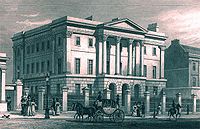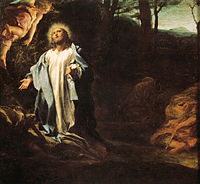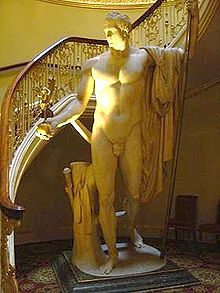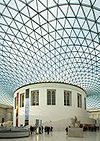- Apsley House
-
Apsley House
Apsley House, as it is today, Hyde Park Corner, London.General information Architectural style neo-classical Town or city London, England Country United Kingdom Construction started 1771 Design and construction Client Henry Bathurst, Lord Apsley; Arthur Wellesley, 1st Duke of Wellington Architect Robert Adam
Benjamin Dean Wyatt (extensive renovations)Apsley House, also known as Number One, London, is the former London residence of the Dukes of Wellington. It stands alone at Hyde Park Corner, on the south-east corner of Hyde Park, facing south towards the busy traffic interchange and Wellington Arch. It is a grade I listed building.
The house is now run by English Heritage and is open to the public as a museum and art gallery, although the 8th Duke of Wellington still uses part of the building as a part-time residence. It is sometimes referred to as the Wellington Museum. It is perhaps the only preserved example of an English aristocratic town house from its period. The practice has been to maintain the rooms as far as possible in the original style and decor. It contains the 1st Duke's collection of paintings, porcelain, the silver centrepiece made for the Duke in Portugal, c 1815, sculpture and furniture. Antonio Canova's heroic marble nude of Napoleon as Mars the Peacemaker made 1802-10, holding a gilded Nike in the palm of his right hand, and standing 3.45 metres to the raised left hand holding a staff. It was set up for a time in the Louvre and was bought by the Government for Wellington in 1816 (Pevsner) and stands in Adam's Stairwell.
Contents
History
The house was originally built in red brick by Robert Adam between 1771 and 1778 for Lord Apsley, the Lord Chancellor, who gave the house its name. Some Adam interiors survive: the semi-circular Staircase, the Drawing Room with its apsidal end, and the Portico Room, behind the giant Corinthian portico added by Wellington.
In 1807 the house was purchased by Richard Wellesley, 1st Marquess Wellesley, the elder brother of Sir Arthur Wellesley, but in 1817 financial difficulties forced him to sell it to his famous brother, by then the Duke of Wellington, who needed a London base from which to pursue his new career in politics.
Wellington employed the architect Benjamin Dean Wyatt to carry out renovations between 1818 and 1819. He extended the house by adding two bays westward to the original five; built the Waterloo Gallery for the Duke's paintings, and faced the red brick with the grander golden Bath stone. He also introduced his own version of French style to the interior, notable in the Waterloo Gallery and the florid wrought iron stair-rail, "just turning from Empire to a neo-Rococo" (Pevsner).
The Waterloo Gallery is, of course, named after the Duke's famous victory over Napoleon at the Battle of Waterloo. A special banquet is still served annually to celebrate the date — 18 June 1815. The Duke's equestrian statue can be seen across the busy road, cloaked and watchful, the plinth guarded at each corner by an infantryman. This statue was cast from guns captured at the battle.
The house was given the popular nickname of Number One, London, since it was the first house passed by visitors who travelled from the countryside after the toll gates at Knightsbridge.[1] It was originally part of a contiguous line of great houses on Piccadilly, demolished to widen Park Lane: its official address remains 149 Piccadilly, W1J 7NT.
During the Second World War, it was rumoured that King George VI and Queen Elizabeth heard that the treasures of the house hadn't been evacuated. The story goes that they both arrived in a van and quickly had the objects moved to Frogmore for safekeeping.[2]
Gerald Wellesley, 7th Duke of Wellington, gave the house and its most important contents to the nation in 1947, but by the Wellington Museum Act 1947 the right of the family to occupy just over half the house was preserved "so long as there is a Duke of Wellington".[3] The family apartments are now on the north side of the house, concentrated on the second floor.
Timeline
1778 - Apsley House was first finished in 1778 for Lord Apsley, a Lord Chancellor, who named the house
1828 - The Waterloo Gallery,made by Wyatt in 1828, is the main piece of Apsley House. A banquet was held in this vast 90-foot corridor every year on the anniversary of the great victory over the French at Waterloo.
1846 - This bronze equestrian statue of the Duke of Wellington, by Matthew Cotes Wyatt, is placed over the Triumphal Arch, Hyde Park Corner
Paintings collection
The magnificent collection of 200 paintings includes 83 which were acquired by the first Duke after the Battle of Vitoria in 1813, the paintings were in Joseph Bonaparte's baggage train, they were from the Spanish royal collection and were presented to Wellington by King Ferdinand VII of Spain. The painting collection includes work by:[4]
American School
English School
-
- Sir William Beechey
- John Burnet
- George Dawe
- John Hoppner
- Edwin Landseer
- Sir Thomas Lawrence
- William Salter
- Sir David Wilkie
Dutch School
Flemish School
-
- Paul Brill
- Adriaen Brouwer
- Jan Brueghel the Elder
- Anthony van Dyck
- Antony Francis van der Meulen
- Rubens
- David Teniers the Younger
French School
-
- Claude Lorrain
- Claude-Joseph Vernet
German School
Italian School
Spanish School
-
- Velázquez, Diego (4 paintings, including The Waterseller of Seville)
- Francisco Goya (1 painting)
- Bartolomé Esteban Murillo (3 paintings)
- Jusepe de Ribera (3 paintings)
The 1st Duke received many gifts from European rulers that are displayed in the House:
- A pair of large candelabra of Siberian porphyry, ormolu & Malachite centre and two side tables, presented by Nicholas I of Russia.
- A pair of Swedish porphyry urns, from King Charles XIV John of Sweden.
- A dinner service of Berlin porcelain, from Frederick William III of Prussia.
- The Egyptian revival decorative arts dinner service of Sèvres porcelain, from Louis XVIII of France.
- The silver and silver-gilt Portuguese service of over a thousand pieces, from the Portuguese Council of Regency.
- The Saxon Service of Meissen porcelain, from Frederick Augustus I of Saxony.
- One dozen marshal's batons from various rulers.
The Duke's uniform and other memorabilia may be seen in the basement.
See also
- Stratfield Saye House - the country house of the Dukes of Wellington
References
- ^ Aspley House (English Heritage) accessed 13 March 2009
- ^ Blaikie, Thomas, You look awfully like the Queen: Wit and Wisdom from the House of Windsor. HarperCollins, 2002. ISBN 0-00-714874-7.
- ^ Daily Telegraph: "Heritage held hostage to class war" by Adam Nicolson
- ^ the list from: Apsley House Wellington Museum, Simon Jervis, Maurice Tomlin & Jonathan Voak 1995
- Jervis, Simon and Tomlin, Maurice (revised by Voak, Jonathon) (1984, revisions 1989 & 1995) Apsley House Wellington Museum published by the Trustees of the Victoria and Albert Museum, London ISBN 1-85177-161-1
- Nikolaus Pevsner, The Buildings of England: London vol. I, p 463. ISBN 0300096534
External links
- Apsley House and Park Lane, Old and New London: Volume 4 (1878), pp. 359-375
- Page on English Heritage's website
- Aerial photo and map - Apsley House is marked "Wellington Museum".
- Tourist information on Apsley House
- Historical Images of Apsley House
Arthur Wellesley, 1st Duke of Wellington Family Father: Garret Wesley, 1st Earl of Mornington · Mother: Anne Hill · Brothers: Richard Wellesley, 1st Marquess Wellesley · William Wellesley-Pole, 3rd Earl of Mornington · Henry Wellesley, 1st Baron Cowley · Sister: Lady Anne Smith · Wife: Catherine Wellesley, Duchess of Wellington · Children: Arthur · Charles
Battles and wars Flanders Campaign · Battle of Boxtel · Fourth Anglo-Mysore War · Battle of Seringapatam · Second Anglo-Maratha War · Battle of Assaye · Peninsular War · Battle of Roliça · Battle of Vimeiro · Second Battle of Porto · Battle of Talavera · Battle of Sabugal · Third Siege of Badajoz · Battle of Salamanca · Battle of Vitoria · Hundred Days · Battle of WaterlooHomes and Honours Apsley House · Stratfield Saye House · Walmer Castle · Wellington's Column · Wellington Monument, Dublin · Wellington Statue, AldershotCategories:- Art museums and galleries in London
- English Heritage sites in London
- Houses in Westminster
- Biographical museums in London
- Grade I listed houses
- Grade I listed buildings in London
- Historic house museums in London
- Museums in Westminster
- Arthur Wellesley, 1st Duke of Wellington
-
Wikimedia Foundation. 2010.








